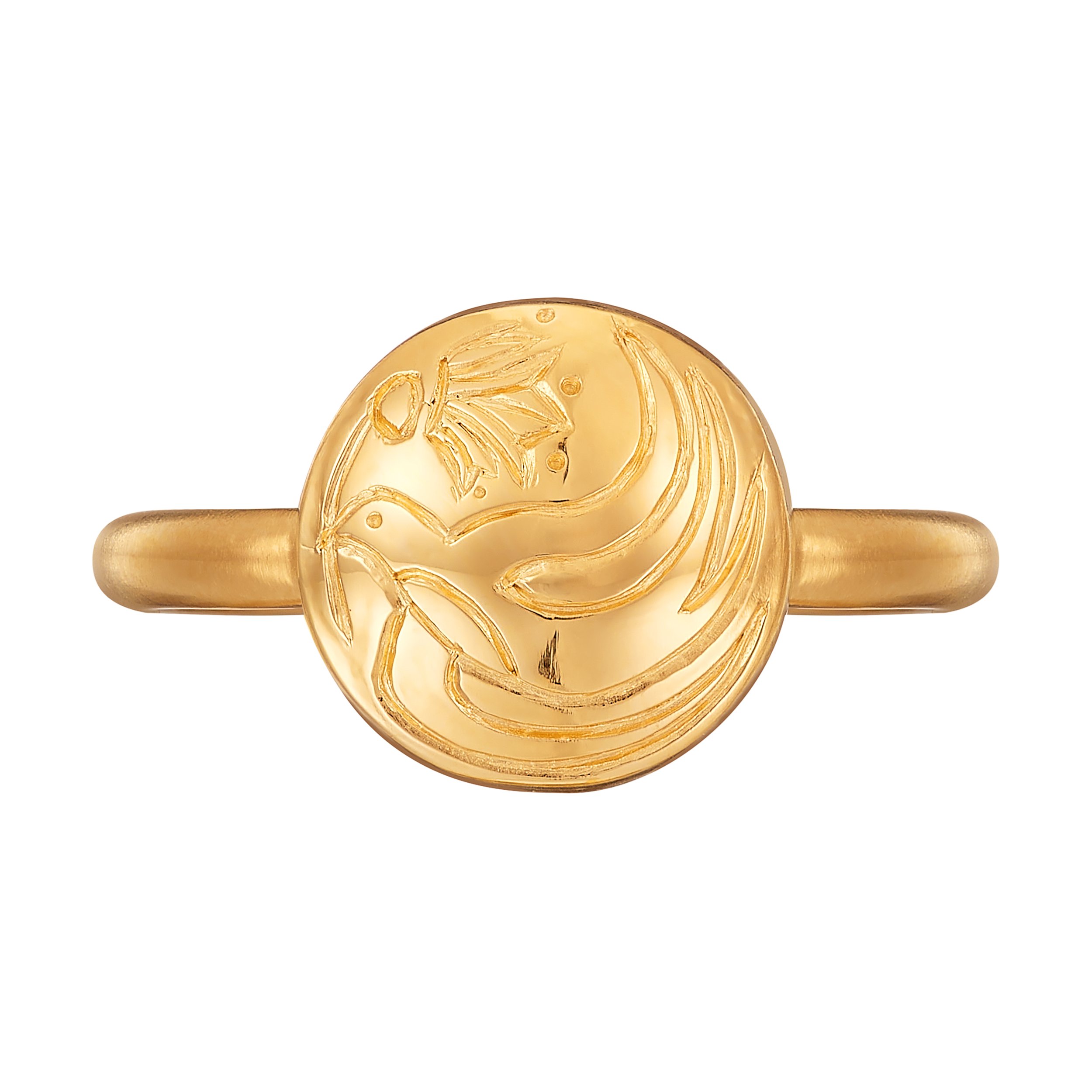Flora, Goddess of Flower Mini Ring
18ct yellow gold, handmade to order in Geneva
Symbols: Roses, Butterfly Wings, Crown of Flowers, Crown
A nymph (Chloris in the Grecian tradition) was kissed by the West Wind, Zephyr, and was turned into the goddess Flora. Immortalised by Sandro Botticelli in Primavera, a representation of her distinguished only by a floral crown appeared on coins of the Roman republic.
According to Ovid, Flora gave Juno a magic flower to help her become pregnant with Mars as a retort to the birth of Minerva from Jupiter’s head. Her festival, called the Floralia, was instituted in Rome in 238 BC. For the Romans, the festival symbolized the cycle of life, birth, and death with dancing, gathering of flowers, and a bawdy overtone that started with the wearing of colourful clothes but often ended without them.
The celebration of spring is still marked in many northern hemisphere countries; in Britain the celebration of May Day has many resemblances some of the activities of Floralias dating back to before Christianity. The Celtic traditions of collecting flowers, decorating a May bush or creating a Maypole, crowning a May Queen and making offerings to the fairies are very reminiscent of Floralias. This connection with earthly sensuality and as a goddess of Spring connect Flora to Aphrodite, making her another Goddess for Taureans
18ct yellow gold, handmade to order in Geneva
Symbols: Roses, Butterfly Wings, Crown of Flowers, Crown
A nymph (Chloris in the Grecian tradition) was kissed by the West Wind, Zephyr, and was turned into the goddess Flora. Immortalised by Sandro Botticelli in Primavera, a representation of her distinguished only by a floral crown appeared on coins of the Roman republic.
According to Ovid, Flora gave Juno a magic flower to help her become pregnant with Mars as a retort to the birth of Minerva from Jupiter’s head. Her festival, called the Floralia, was instituted in Rome in 238 BC. For the Romans, the festival symbolized the cycle of life, birth, and death with dancing, gathering of flowers, and a bawdy overtone that started with the wearing of colourful clothes but often ended without them.
The celebration of spring is still marked in many northern hemisphere countries; in Britain the celebration of May Day has many resemblances some of the activities of Floralias dating back to before Christianity. The Celtic traditions of collecting flowers, decorating a May bush or creating a Maypole, crowning a May Queen and making offerings to the fairies are very reminiscent of Floralias. This connection with earthly sensuality and as a goddess of Spring connect Flora to Aphrodite, making her another Goddess for Taureans
18ct yellow gold, handmade to order in Geneva
Symbols: Roses, Butterfly Wings, Crown of Flowers, Crown
A nymph (Chloris in the Grecian tradition) was kissed by the West Wind, Zephyr, and was turned into the goddess Flora. Immortalised by Sandro Botticelli in Primavera, a representation of her distinguished only by a floral crown appeared on coins of the Roman republic.
According to Ovid, Flora gave Juno a magic flower to help her become pregnant with Mars as a retort to the birth of Minerva from Jupiter’s head. Her festival, called the Floralia, was instituted in Rome in 238 BC. For the Romans, the festival symbolized the cycle of life, birth, and death with dancing, gathering of flowers, and a bawdy overtone that started with the wearing of colourful clothes but often ended without them.
The celebration of spring is still marked in many northern hemisphere countries; in Britain the celebration of May Day has many resemblances some of the activities of Floralias dating back to before Christianity. The Celtic traditions of collecting flowers, decorating a May bush or creating a Maypole, crowning a May Queen and making offerings to the fairies are very reminiscent of Floralias. This connection with earthly sensuality and as a goddess of Spring connect Flora to Aphrodite, making her another Goddess for Taureans
The Goddess collection is inspired by the character and mythology of powerful Roman and Grecian legends, and the overlap into other forms of cultural and philosophical representation. Alice was inspired by the way that symbols in fine art would have been instantly recognisable for the narratives they represented, in a way that only experts schooled in art history would likely now recognise. Symbolism is such a powerful force in contemporary jewellery, and as an artist with strong female clients and collaborators, Alice wanted to explore characteristics that would be meaningful and enduring.
After a decade of working in meenakari enamel, an engraved process, Alice collaborated on this collection with Colombian goldsmith Juan Sebastian Galan Bello to create stories in repousse 18 carat yellow gold - from working inwards to working outwards. Juan realised in gold a series of illustrations created with Charlotte Gastaut, a Parisian illustrator working with brands such as Diptique and Hermes, and on the creation of her own fairytale narratives rendered in print and on silk.



